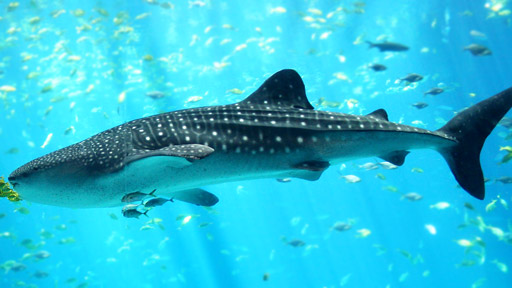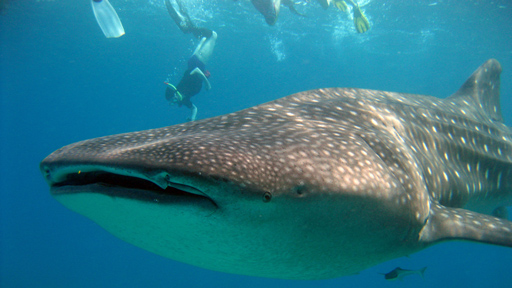
They are the largest fish on the planet, reaching more than 40 feet in length and weighing up to 47,000 pounds. But as intimidating as their size may seem, whale sharks are virtually harmless.
Unlike other sharks, these beautiful, bus-sized behemoths don’t have an appetite for flesh. Instead, they feed on plankton, which they filter through their oversized mouths while ingesting large volumes of water. When they do encounter people, they are docile and friendly, often allowing divers to swim alongside them.
As it turns out, humans pose a greater threat to these beautiful fish than they do to us.
In China and other countries, hundreds of whale sharks are brutally slaughtered each year for their fins, skin, and oil. If that number doesn’t scare you, it should — only about 7,000 whale sharks have been sighted in the wild and researchers don’t know how large the global population is.
The fish are listed as an endangered species by the International Union for Conservation of Nature, and hunting and selling whale sharks illegal in many countries, including China. But enforcement is difficult.

Whale shark carcasses can sell for about $30,000 each on the black market, with the meat and massive fins used for shark fin soup in China. The skin and oil are exported to North America and Europe, where they are used to make accessories and fish oil supplements.
In 2013, an undercover investigation revealed that a single factory in China had been butchering approximately 600 whale sharks each year. A couple years later, a viral video posted to YouTube showed two men sawing a whale shark into pieces while it was still alive.
But overfishing is not the only threat these unlucky giants face. Whale sharks are often caught as bycatch by fishing vessels, entangled in trawling nets or injured in boat collisions.
To make matters worse, the sharks take up to 30 years to reach sexual maturity. As the adults die off, the rate of reproduction declines, meaning threatened populations can’t bounce back quickly.
In fact, scientists say fewer adults have been spotted in recent years. According to National Geographic, large whale sharks haven’t been spotted in many of the world’s oceans for at least a decade. Outside of the eastern Pacific, scientists have only seen whale sharks averaging less than 23 feet, and those are still babies.
Since so much is still unknown about whale sharks, including their population size and migration habits, it’s difficult to tell how one country’s actions are affecting populations in other places.
“Given that they’re highly migratory on a global scale, protection in one country will not assist the conservation of these animals is they move out of that jurisdiction and they’re in an area where they’re actively hunted,” Brad Norman, director of the non-profit marine conservation organization ECOOCean told ABC News.
WATCH: Whale Shark Rescue: Divers Free 4 Whale Sharks Caught in Net
If these divers were not there to free them from the net, they almost certainly would have died.




